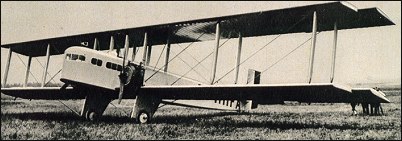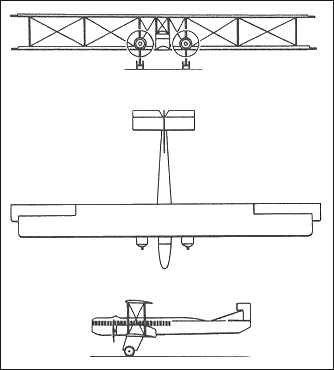 |
Farman F.60 Goliath1918 |  |
| PASSENGER | Virtual Aircraft Museum / France / Farman |
 |
The two FF.60 bomber prototypes of 1918 heralded the start of a great family of passenger airliners and night bombers which dominated European aviation for the next decade. However the design formula remained fairly constant with equal-span biplane wings and a conventional monoplane-type tail unit. The landing-gear legs had trousered fairings and each supported twin wheels. Immediately above each leg was an engine set in a large nacelle on the lower wing, with minimal clearance between the propeller and the slab-sided fuselage. Bomber versions invariably had gunners' cockpits in the nose and amidships, while the pilot and co-pilot/navigator were seated in tandem in open cockpits. Commercial transport Goliaths had a nose cabin for four passengers and an aft cabin for eight, separated by a raised open cockpit for the two pilots under the leading edge of the upper wing. About 60 commercial Goliaths were built in several versions with Salmson, Renault, Lorraine, Gnome-Rhone-built Jupiter, Armstrong Siddeley Jaguar and Farman engines, among the most important being those powered by 171.4kW Salmson Z.9 radial engines operated by Air Union. Several flew with other airlines including the Farman airline, and indeed it was this company that started the world's first regular international passenger service, beginning on 22 March 1919 between Paris and Brussels. Of course this had not been the first international passenger service by an airline between European capital cities, this being officially recognised as the Farman flight between Paris and London on 8 February 1919 carrying military personnel. However the latter was not the start of a sustained or civil passenger service and as such does not conflict with the Paris-Brussels "first". Versions operated by the Farman airline included the Renault-powered F.61 and Gnome-Rhone-built Jupiter-powered F.63bis. Six passenger-carrying Goliaths were also built under licence in Czechoslovakia, two going to the air force. Thirty-six F.60 bombers (with Salmson engines and cut-down noses) served with the French 21 and 22 Regiments d'Aviation and 24 square-nosed Jupiter-powered Goliaths equipped naval escadrilles 6R1, 6B1 and 6B2, following tests with a passenger type. These could be mounted on twin floats (with stabiliser floats under the lower wings) as an alternative to the normal wheel-type landing gear. Russia purchased sufficient F.62s to equip two units which formed the embryo of its new heavy bomber force; Japan and Italy bought a single example each for testing; and Poland acquired 32 F.68 bombers. Export bombers - like the 42 F.63 for the French Army and a large batch of F.65 for the French Navy - each had a 'balcony'-type nose-gunner's cockpit with a 'step' below.
|  COMPANY PROFILE | ||||||||||||||||||||||||||||||||||||||||||||||||||||||
 |

|

